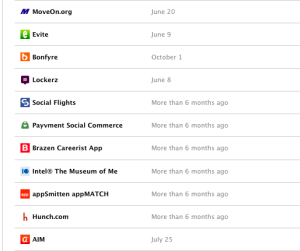Best security practice often tells you to limit your attack surface to the bare minimum, which means you need to be aware of what that surface looks like. When it comes to our social networks though, we tend to ignore exactly how exposed we can be as we share all sorts of information with the world.
One of these areas that has slipped through my attention, and probably yours as well, is the number of apps you have allowed access to your Facebook, Twitter and LinkedIn accounts. The answer is probably more than you think. It took a security message from Twitter last week to have me investigate the situation, and it wasn’t pretty.
 Now granted, I test a lot of apps for a living and chances are that I have actually used each of the ones that I have authorized to my accounts. But I was surprised that I had more than 100 apps that could access my Twitter and Facebook account, and 70 on LinkedIn. Many of them I couldn’t even recall what they did, given that I probably used each one once, found out that it wasn’t up to snuff, and moved on to testing something else out. But I never actually revoked access from my account for any of these apps since I added them.
Now granted, I test a lot of apps for a living and chances are that I have actually used each of the ones that I have authorized to my accounts. But I was surprised that I had more than 100 apps that could access my Twitter and Facebook account, and 70 on LinkedIn. Many of them I couldn’t even recall what they did, given that I probably used each one once, found out that it wasn’t up to snuff, and moved on to testing something else out. But I never actually revoked access from my account for any of these apps since I added them.
So let’s take some time now to clean things up and eliminate the apps that you no longer use or find relevant to your social networking way of life. Here are the links to the various places that will allow you to peruse your app access:
https://www.facebook.com/settings?tab=applications
https://twitter.com/settings/applications
https://www.linkedin.com/psettings/permitted-services
https://security.google.com/settings/security/secureaccount?pli=1
LinkedIn has the easiest of the three to eliminate unknown or uninteresting apps: you just go down the list and check off the ones you want to remove. There are actually two sections for the LinkedIn page: the actual apps that typically display something on your main LinkedIn profile page or interact with content (such as Slideshare presentations or blog posts) that appear on your profile, and links to external websites. The former you can investigate further. The latter you don’t really have any hot link or any information about the external site, which is somewhat lacking. Each of the actual apps has really only one possible setting to adjust: whether you display the app on your profile or your LinkedIn homepage. You have to click on the “about” link to make this adjustment, however.
With Twitter and Facebook you have to revoke access to each app one by one. Facebook actually has done some good work here (despite their reputation for whoring your privacy data). For each app, it has the helpful but eventually annoying message that even if you revoke access, there is probably some residual data that is lurking on the app’s own data center that you will have to spend lots of energy to try to remove completely. It also allows you to edit the specific access that each app has to your account: it tells you what data the app collects from you, who has access to this information on your timeline, and when it last accessed your information. That is all very useful, but somewhat time consuming if you are really serious about revoking access.
Twitter has the least information available for each app, and just a binary decision: allow or revoke. Each app is shown with the level of access to your account: read, write or sending direct messages. You can’t adjust these once you have approved the app.
So take a few moments now and clean up your apps! Your account will be safer, and you will feel better about reviewing your connected life.
No doubt, my grand mother was right … Ah! housekeeping.
Good advice, Thx.
Pingback: What Are Your 5 Biggest Online Privacy Worries? - Dice News
Pingback: The widening Adobe breach | David Strom's Web Informant